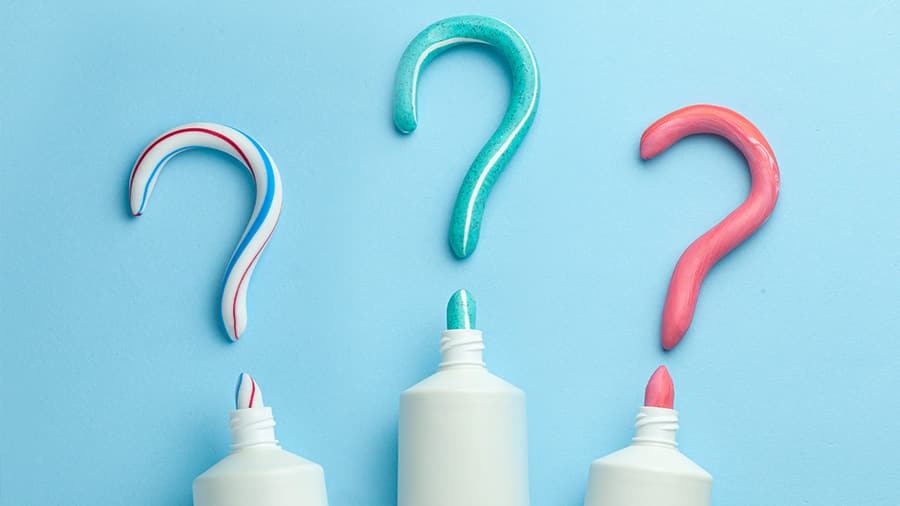Three Types of Teeth Stains
Stains fall into one of three categories based on where they occur on the tooth and how they form. The categories of teeth stains are extrinsic, intrinsic, and age-related stains.
Extrinsic Tooth Stains
An extrinsic tooth stain is a stain on the outer part of the tooth. These stain molecules make their home on your enamel, which is the layer of the tooth that protects the softer part of the tooth (dentin) underneath. Even though enamel is the hardest part of the tooth, it comes in contact with everything you eat or drink and can absorb some of the pigment over time, causing a stain on the surface of your teeth. The good news is that extrinsic teeth stains do not move below the enamel to the inner part of the tooth, which means it’s easier to remove them!
Intrinsic Tooth Stains
Intrinsic teeth stains occur below the enamel - on a sensitive layer called dentin. Dentin is naturally darker and more yellow in colour and is exposed when the enamel is thinned or worn down from wear or poor dental hygiene. These stains are a little tougher to remove, but do not worry; it can be done!
Age-related Stains
Like many things in your body, your teeth show signs of ageing as you get older. You can expect to see two central changes to your teeth as you age: your dentin gets darker, and your enamel gets thinner. The combination causes unwanted tooth discolouration that, unfortunately, is out of your control.
Similar to intrinsic stains, age-related staining affects the dentin of your teeth. So, it would be most effective to treat this type of tooth stain with a product that uses an effective whitening ingredient like hydrogen peroxide. Newer technologies like oxygenated whitening or professional whitening treatments done in a dentist clinic can also help.
Reasons for Teeth Stains
Stained teeth often result from lifestyle habits, food habits, poor oral hygiene, health issues, and ageing processes. Understanding the common causes of stains makes it possible to modify habits and behaviours to prevent tooth stains and discolouration. Major sources of stain in teeth include:
Certain coloured or pigmented food or drinks - like coffee, tea, wine, etc.
Smoking or consuming tobacco
Inadequate oral care
Genetics and other natural factors
Certain medications or antibiotics
Natural wear and tear of enamel with age
Accidents or trauma
How To Remove Stains From Teeth
With some time and effort, it is possible to find products and treatments that can remove stains and fit within one’s budget and lifestyle.
Removing Teeth Stains at Home
There are also several at-home products and methods you can try to help lift stains and brighten your smile. Some options include:
- Whitening Toothpaste: Using a whitening toothpaste is a great way to remove extrinsic and intrinsic stains from the comfort of your home. Many whitening toothpastes contain mild abrasives that help to remove build-up and surface stains. Some toothpastes also might contain a whitening ingredient like hydrogen peroxide active oxygen that goes beneath the surface to remove deep-set stains. Using whitening toothpaste is the easiest remedy to remove stains on teeth since it’s easily incorporated into something you already do (or should do) twice daily.
- Purple Teeth Whitening Serum: For those looking to combat yellow discoloration specifically, *Colgate Visible White Purple Serum offers an innovative approach to teeth whitening. This specialized serum utilizes color correction technology to neutralize yellow tones and actively whiten teeth. For an extra whitening boost*, we recommend incorporating Visible White Purple Serum into your regular oral care routine as needed. It's particularly effective in color correcting the yellowish tones* which may be caused by coffee, tea, and tobacco stains.
*for temporary efficacy.
*vs brushing with Colgate non whitening toothpaste alone.
Eliminating Tooth Stains With Colgate Visible White Booster Gel: Colgate’s innovative product, the Visible White Booster Gel, offers an instant and efficient solution to remove tooth stains and whiten teeth. With regular use, it reveals visibly whiter teeth in just 14 days. This innovative product is worth considering, especially if you need to enhance your smile for an upcoming occasion in a short span of time.
The Colgate Visible White Booster Gel contains a revolutionary active oxygen formula that works beyond the enamel surface to break down deeper stains and lighten the tooth shade. With an easy three-step process - squeeze, apply, leave-on - this gel helps achieve whiter teeth in two weeks. The best results can be met by using the gel twice daily after brushing.
Teeth Whitening Kits (Gel + Tray): Similar to whitening pens, teeth whitening gels are available over the counter or from your dental professional. These teeth whitening gels typically contain peroxide-based bleaching agents, but in higher doses than in whitening toothpastes. The whitening tray can help accelerate the whitening effect from the gel or help apply the gel in a targeted, safe way. You can also get a custom-fit tray from your dental professional. Custom trays are usually more effective and better at protecting your gums, but they can be much more expensive than other over-the-counter options.
Teeth Whitening Strips: This at-home method uses whitening gel but pre-applies it to strips for easy application without a tray. It can be a reliable stain remover for teeth. Whitening strips may cause sensitivity as a side effect because of the high amounts of hydrogen peroxide or carbamide peroxide, so choose carefully and make sure you're looking at the ingredients before adding them to your cart. Consider trying whitening strips that you can purchase over-the-counter. Pick up a pack at the store and follow the directions on the package to get started on brightening your smile.
In-Office Bleaching
If your teeth stains won’t budge with an at-home whitening technique, talk to your dental professional about professional in-office bleaching to remove stains from teeth. Although this method is known to be the most effective way to clean discoloured teeth, it can also be the most expensive course of action, and may not recommended if you are suffering from tooth sensitivity.
There’s no need to be afraid of flashing your winning smile. Removing teeth stains at home or at the dental professional's office has never been easier! With advanced whitening methods now accessible, you can comfortably display your happiest, most radiant smile.
Frequently Asked Questions
What causes staining of teeth?
A variety of factors can cause stains on teeth. Having pigmented food or drinks like coffee, tea, red wine, or inadequate brushing and flossing are common culprits that allow stains to build up on tooth enamel over time. Tobacco use, certain medications, and genetics can also contribute to tooth discolouration. As we age, enamel naturally thins, revealing the yellowish dentin underneath. Teeth stains can be prevented and managed with regular dental cleanings, checkups, and early intervention when yellow stains appear.
How to remove stains from teeth?
For mild surface-level stains or deeper rooted stains, teeth-whitening toothpaste offers convenient stain removal at home. If home remedies fall short, in-office bleaching and teeth whitening treatments deliver powerful results under a dental professional's supervision. While veneers or crowns mask deep stains, they're the most invasive and expensive option.
Can you fix stained teeth?
Several effective methods exist to remove extrinsic and intrinsic stains on teeth. Whitening toothpaste, pens, gels, and strips can help lift surface extrinsic stains at home. Professional in-office bleaching treatments using strong bleaching agents like hydrogen peroxide are highly effective for removing deeper, intrinsic, and stubborn stains. The best approach depends on the type and severity of the stained teeth, so consulting a dental professional can help determine the ideal solution.
Are tooth stains harmless?
Tooth stains, while not inherently harmful to teeth, can be like warning lights on your smile. They might indicate underlying oral health issues or poor oral hygiene, leading to gum disease and decay. Consult your dentist for any tooth discoloration to identify the cause and find the best treatment.
This article is intended to promote understanding of and knowledge about general oral health topics. It is not intended to be a substitute for professional advice, diagnosis or treatment. Always seek the advice of your dentist or other qualified healthcare provider with any questions you may have regarding a medical condition or treatment.
ORAL HEALTH QUIZ
What's behind your smile?
Take our Oral Health assessment to get the most from your oral care routine
ORAL HEALTH QUIZ
What's behind your smile?
Take our Oral Health assessment to get the most from your oral care routine













